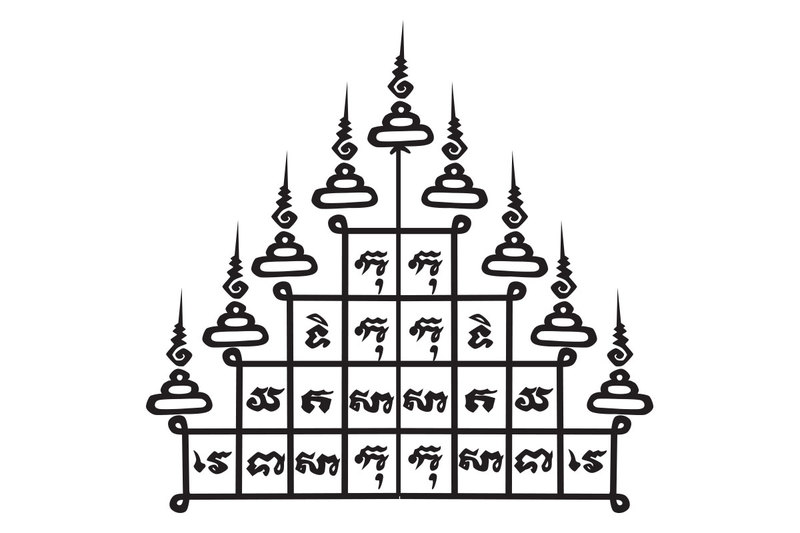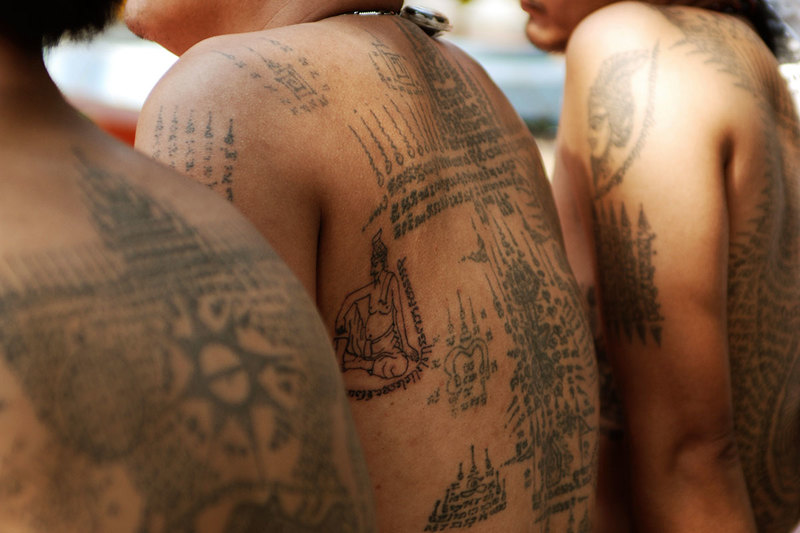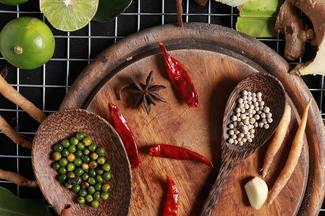SAK YANT TATTOOS – THE MYSTICAL SYMBOLISM OF INK ON SKIN

Even a first-time visitor to Thailand soon becomes aware of how deeply mysticism and symbolism are entwined and embedded within the very fabric of Thai society. The visual aesthetic of Thai culture is defined by it. It is all around you in the pictorial imagery, statuary and even in the very gestures of social interaction. One particularly striking form of the potency of symbolism among Thai males is the practice of tattooing, known as Sak Yant.
Unlike the Western tradition of adorning the body as a means of expressing personal identity or as a statement of individuality, Sak Yant tattooing in Thailand embodies a ritualistic, mystical connection with a belief system the origins of which lie thousands of years in the past.
Sak in Thai means tattoo (literally ‘to tap’) and Yant is the Thai form of the Sanskrit word Yantra, meaning ‘machine’ or ‘contraption’. The Yantra is a mystical diagram, principally from the Tantric traditions of Indian religions used in the worship of deities, as aids in meditation, for their protective powers and the benefits of their supposed occult connections.

Art and symbolism working their magic
Yantras are associated with particular deities and take many forms. The designs used in meditation, for instance, tend to favour geometric shapes that radiate out from the centre, typically in emulation of the highly symbolic lotus flower, a manifestation of purity and beauty in both Hinduism and Buddhism, as well as carrying associations with rebirth and spiritual awakening.
Occult Yantras are believed to be powerful good luck charms, representing a deity who may be called upon to protect the wearer and are traditionally consecrated and given force by a monk through the use of mantras during the tattooing process.
Yantra tattooing in Thailand has its roots in tribal animism and the Khmer Hindu-Buddhist traditions, the Khmer Empire and its culture having strongly influenced many aspects of Thai culture during the centuries of its hegemony over the Thais. The practice of Yantra tattooing remains popular today in Cambodia, Thailand Laos and Myanmar and tattoos are created by Ruesi, highly skilled practitioners of the art and Buddhist monks, traditionally using a needle-sharp metal rod called a Khem Sak.
The script used in the designs varies from country to country and within the countries where it is practised. In northern Thailand Shan, northern Thai or Tai Lu scripts are favoured, while in central Thailand and Cambodia the Khmer script is the norm. In Laos the local Lao Tham script is used.
 Art, symbolism and magic powers
Art, symbolism and magic powers
The various scripts are abbreviated syllables from Pali (the sacred language of Buddhist texts) incantations, which Yantra masters have adapted to their designs over many centuries, purportedly through visions received during meditation. A number of Yantra designs have very ancient origins in animistic beliefs and have been incorporated into the Buddhist traditions.
In modern Thailand Yantra tattoos are believed to confer magical and mystical powers, offer protection or bring good fortune, while other may serve to make the wearer more eloquent in speech. Those designs offering protection from evil and danger are understandably favoured by men in dangerous prefessions, like police officers, army personnel, taxi drivers!, and not surprisingly the criminal classes.
It is believed that the power invested in the tattoo decreases over time and so must be augmented by performing a Wai Khru ritual, literally ‘paying homage to one’s guru’. In Thailand the biggest and most famous of these Wai Khru rituals takes place at Wat Bang Phra, a Buddhist monastery in the Nakhon Chaisi district of Nakhon Pathom Province, some 50 kilometres to the west of Bangkok.
 Wat Bang Phra, venue for the annual festival
Wat Bang Phra, venue for the annual festival
Founded in the 18th century near the spot where a highly revered Buddha image was recovered from a boat which sank in the river on its way from the former capital Ayutthaya, it is today famous as a Sak Yant centre. Each day the monks give tattoos to both locals and foreigners and once a year in March on the temple grounds the Sak Yant festival is held, when disciples and devotees gather to honour their masters and have their tattoos reinvigorated and blessed. But, be warned. It can be very rowdy and often seems utterly mad and out of control, but as with many things Thai, it’s all part of the show.
There are very many Yantra designs, divided into various categories according to the desired effect of the devotee. Amnaj, for example, is favoured by those seeking power in both a physical and spiritual way, and is popular with people who need to command respect and obedience. The Mahaa Saneh design is for anyone looking to make themselves more charming and attractive to the opposite sex, while the Klaew Klaad design confers protection from fatal accidents and danger – very popular with taxi drivers.
Like many rituals and practices in Thailand, Sak Yant embodies beauty and purpose, and cherished traditions and beliefs that are as fascinating as they are ancient. You don’t have to be a believer to appreciate the dexterity and skill, the artistry and symbolism that carry with it a mystical element that is visually attractive and powerfully alluring, drawing adherents from both Thailand and abroad in huge numbers.










of collaborative energy




Before proceeding to use the website please carefully ready our Terms and Policies
I accept Diwerent's Terms and Conditions and Privacy Policy













